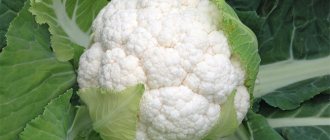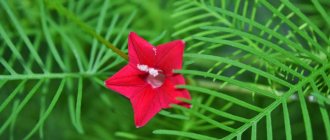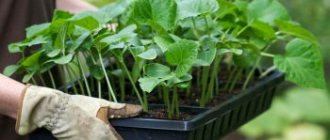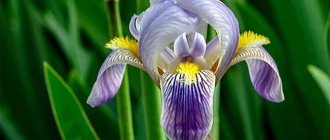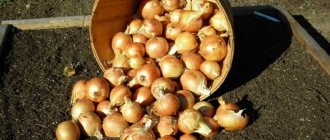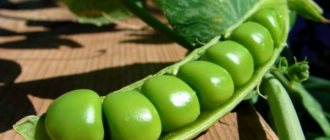Description of culture
Lentils are an annual herbaceous plant whose height reaches sixty centimeters. The bush is not large in size. Its stems have a tetrahedral shape and a reddish tint. They are erect or lodging, depending on the variety. The entire length of the stems is covered with hairs of small size and medium hardness.
Lentils have complex leaves with a pinnate structure. The petiole at the base has a tendril, which can be branched or simple. The size and shape of stipules differ in different varieties of lentils. Short flower stalks have one or several small flowers, shaped like moths. Most often the petals are painted white, but they can be blue-blue or violet-blue.
The growing season varies depending on the variety, weather conditions and soil. Its duration can be from two and a half months to four. Until the flowering period has arrived, which occurs at the end of May - beginning of June, it grows slowly. When the first flowers appear (six weeks after germination), the growth and branching of the bush accelerates.
Crop varieties
It is quite difficult to find lentil seeds on sale. The most common varieties in our latitudes are:
- Lyubava. This is a mid-season variety that is known for the nutritional and beneficial properties of the fruit. Ripe beans have a light yellow tint. It takes approximately 70 days to fully mature. Bushes of this variety can grow up to 0.6 m in height.
- Anthia. This is a mid-season variety, the seeds of which require 81 to 90 days to ripen. Ripe seeds have a smooth surface and remain green. The fruits of this variety have high culinary qualities. It is also worth noting the resistance of this variety to many ailments and drought.
- Lugansk. A mid-season variety that requires 81 to 95 days to ripen. This species is known for its drought tolerance and high yield. Moreover, this culture has high taste qualities.
- Stepnaya 244. This variety was bred quite a long time ago, namely, back in the days of the Soviet Union. It is resistant to drought and shattering. The bean seeds of this variety are yellow. When cooked, they boil well.
There are several types of lentils. Based on the size and shape of the seeds, as mentioned above, small-seeded and large-seeded lentils are distinguished. The latter is also called plate. Small seeds are more difficult to grow and therefore usually cost more.
It is also worth highlighting the following types:
- Green or unripe brown lentils. This is a very useful product for people who suffer from diabetes, as well as diseases of the stomach and intestines. It takes at least an hour to prepare these fruits. However, it turns out to be a very tasty dish. This type of lentil can be used to feed small children.
- There are also brown lentils, which are most often used for preparing first courses, cereals, salads and snacks. If you pre-soak the seeds, they will be ready in just 25 minutes. If you add the fruits of this variety to first courses, they will give them a nutty aroma. The grain is able to keep its shape even with prolonged heat treatment.
- Another type of lentil is black. She was bred in Canada. It has small seeds about 30 mm in size. It cooks quite quickly - it only takes 20 minutes. At the same time, the finished seeds have an excellent taste.
- Red or, as they are also called, Egyptian lentils. It only takes 15 minutes to prepare. In some cases even less. The fruits make delicious soups and purees. This type of bean contains a lot of iron, which makes them especially useful for people suffering from anemia.
Characteristics of the fetus
This is a bean that ripens in one nest with two doors. It is elongated, diamond-shaped and prone to cracking when overripe. There are few fruits, from one to three pieces. They have a round or flattened shape and small sizes, up to two centimeters in length.
The fruits are yellow, red, green, pink, brown, gray, black, with a marbled dotted or spotted pattern.
Disease and pest control
Main diseases of lentils:
- Powdery mildew. This is a fungal disease, which is characterized by the appearance of a white powdery coating on the above-ground parts of the plant - the mycelium of the fungus. Over time, when the pest spores mature, the coating becomes gray. The parasite prevents the plant from carrying out photosynthesis, which reduces the yield by 20%. The fungus overwinters in plant debris and becomes active in hot, dry weather.
- Ascochytaosis. Fungal disease. Yellow spots with a brown edge appear on the above-ground parts of the plants, which over time turn into brown pycnidia. The risk of disease increases in high humidity conditions. Losses amount to up to 30%; defective seeds are formed on diseased plants.
- Rust. Mycosis affects all above-ground organs of plants, as a result of which rusty-brown spots appear on them, which turn black over time. With a large degree of damage, necrosis develops on the leaves and they fall off. Productivity is reduced by 30%, seed material is produced of low quality.
- Fusarium affects the plant completely. The leaves turn yellow and fall off, the plant stops growing. If the lesion reaches the roots, they turn brown and the plant itself dies. At the bottom of the stem you can see a pinkish coating - fungal spores. The danger of the pathogen is that the seeds of the affected plant accumulate fusariotoxins, which are poisonous to humans and animals. Infection occurs through the soil in which the fungal spores overwinter.
- Root rot. The disease is characterized by the appearance of dark spots in the root collar area. The roots begin to rot, the vascular system of the plants is affected, resulting in their death. The causative agent of the disease is bacteria that are activated in conditions of high humidity.
See also
The benefits and harms of lentils for weight loss, which one to choose, diet recipesRead
To combat diseases, special preparations are used - fungicides and antibacterial agents. The best means of prevention is the selection of resistant varieties. Crop rotation, deep fall plowing, treating crops with Bordeaux mixture, and clearing the area of plant sediments and drafts are considered effective.
Lentil pests:
- Steppe cricket. This is a black insect with developed wings. The larvae have underdeveloped wings, the eggs are white and large (4 mm in length). They eat the green parts of the plant.
- Steppe click beetle. These are black insects with a bronze tint; the larvae are brown. The pest overwinters deep in the soil and eats the green parts of the plant.
- Black weevil. This is a small beetle with gray hairs in the lower part of the abdomen; the larvae are white with a brown head. Leaves and fruits are damaged.
- Pea aphid. The insect damages all parts of the plant until the shoots die.
- Nodule weevil. The pest eats young shoots and the shell of nitrogen-fixing nodules.
- Snails and slugs. They eat young shoots.
Insecticides are used to control pests. Deep moldboard plowing before wintering is effective, which leads to the death of insects and their larvae.
Lentils in Russia
In our country, this culture was known a long time ago, five hundred years ago. In those distant times, lentils were grown in Russia on the Russian Plain. As a grain crop it had high value. Where do lentils grow in Russia? In the last century, its place of growth in our country was the black soil regions of the Volga region and the Urals. Lentils grew in the North Caucasus and Ukraine.
It was called crane peas, sochevitsa, vichka, lyashta. Lentils were used for baking bread, making porridge and soup. Sausages and sweets were made from it. Currently, lentils in Russia grow in the Volga region, the Central Black Earth regions of the country, in small areas of Tatarstan, Mordovia, Chuvashia, and the western regions of Siberia.
Growing Lentils
When choosing a place to plant lentils, it is recommended to give preference to loose, breathable soils: light podzolic, loamy, sandy loam and ordinary chernozems rich in calcium. In heavy, acidic soils the plant will die. Also, soil enriched with nitrogen and humus is not suitable for growing lentils. In such land, all the growth will go into greenery, and the seeds ripen unevenly and lose their taste.
A good lentil harvest requires long daylight hours, so it is better to germinate the seeds before planting, thereby shortening the pre-emergence period. Seeds are planted in rows in heated and moist soil (the temperature should be 7-8 degrees Celsius at a depth of 10 centimeters). Planting depth is 5-6 centimeters, the distance between rows is about 15 centimeters, in a row at least 5 centimeters.
Until flowering, the crop grows very slowly and requires constant protection from weeds and increased moisture supply. During the period of abundant flowering, watering is carried out more carefully so that waterlogged soil does not lead to diseases of the rhizome and developing seeds. In the future, the plant practically does not require watering.
Information: The leader in lentil cultivation in the country is the Volga Federal District, in particular the Saratov region.
Features of cultivation
The legume crop will show all its best qualities if the following features of growing lentils are observed:
- For plant growth, fruit formation and high yield, an important feature should be taken into account. The growing conditions for lentils are such that they need a lot of light over a long period of time for normal growth. Even ten hours of daylight will not satisfy her needs. The plant will be frail, the fruits will not ripen, and the yield will decrease.
- Another feature is the provision of moisture and warmth to the plant from the beginning of the growing season. Later, lentils easily withstand drought.
- Seeds are able to germinate in soil warmed to just five to six degrees Celsius. This temperature is considered low.
- Where do lentils grow? The crop cannot be grown on compacted soils with low fertility.
- How do lentils grow? Immediately after planting, lentils grow slowly. She is very sensitive to the presence of weeds in the neighborhood. Therefore, during this period, the beds should be weeded especially carefully.
- Nitrogen accumulates on the roots, which makes the soil more fertile. For this reason, legumes in general, and lentils in particular, are of interest to agriculture.
- The fruits can be consumed unripe, they are even tastier.
Lentils - what is it?
Lentils are a legume herbaceous plant with a nutty flavor and unusual aroma. The annual plant has several varieties, the names of which come from the color of the fruit. Since the times of ancient civilizations - Ancient Greece, Ancient Rome, Ancient Egypt - descriptions of lentils and what they are are known. The homeland of lentils is considered to be Western Asia and Southern Europe.
On an industrial scale, this legume plant grows in Canada, Turkey, Iran and India.
Due to the presence of nutrients, these legumes can replace cereals, bread and even meat. The grains taste like beans and peas.
Important! The crop does not accumulate nitrates and radionuclides, therefore, even grown in polluted conditions, it remains an environmentally friendly product.
What fertilizers should I apply?
Many people grow lentils in their country houses. After choosing a planting site, the soil must be fertilized so that the beans grow well and produce a high yield. How do lentils grow? For normal growth in the spring before planting and in the fall during digging, the soil must be fertilized to increase its fertility. Complex fertilizers containing phosphorus and potassium are ideal. Fifty grams per square meter is enough.
You can apply other fertilizers. How do lentils grow? There will be good growth and a high yield if, while digging the beds in the fall, you add superphosphate and potassium salt in the amount of 20-50 grams and 10-30, respectively. In spring, the soil is enriched with ammonium nitrate: 10-30 grams per square meter.
Planting in open ground
Although lentils are considered a plant that is unpretentious to growing conditions, choosing a suitable site should be taken very seriously. The place should be sunny and warm. It is better to give preference to light, loose, neutral soil: the best option would be light sandstone or loam.
Lentils do not tolerate acidic soils very well, so if this is the only soil on your site, be sure to carry out procedures that will help reduce the acidity of the soil: for example, standard liming will do.
In spring or autumn (at your discretion), when digging the soil, be sure to apply mineral fertilizers with a predominance of phosphorus and potassium (about 50 g per square meter).
Planting the plant in open ground is carried out in early spring, when the soil has sufficiently warmed/thawed (15-20 cm deep).
Advice. Before sowing, it is advisable to soak the seed material for 20-24 hours in a nutrient solution - a growth stimulator (this way you can increase seed germination by 15-20%).
Immediately before sowing, dry the seeds thoroughly. Prepare small furrows about 5 cm deep in the soil. Place the prepared seeds there. Gently sprinkle them with a small layer of soil and lightly compact it.
After 10-14 days, full-fledged sprouts should appear. Be sure to thin them out to prevent the possibility of weeds appearing in the area. Please note that in the first 30-40 days, lentils grow extremely slowly, so if the sprouts do not gain strength and growth very quickly, do not rush to abandon the plant: after flowering begins, it will begin to grow intensively.
Lentil bushes
Sowing seeds
Planting beans begins early because it is important that accumulated moisture is retained in the soil, otherwise the plants will germinate late. Narrow rows are made in the prepared soil, twenty centimeters from one another. Lentil crops are always dense. The seeds are planted shallowly in the soil, three to five centimeters is enough. They are small in size. Although there are several of them in a pod, the seeds are sown into the ground separately, each at a distance of ten to fifteen centimeters from each other. The deep layers of soil, at the level of sowing seeds, should warm up to a temperature of three to four degrees Celsius. To ensure friendly seedlings, seedlings covered with soil are rolled for closer contact with the ground.
Beneficial properties of lentils
Edible lentils contain 25-31% complete protein, which includes 21 amino acids, including 12 essential ones (threonine, arginine, tryptophan and others). Lentil protein is close in composition to animal protein and is easily digestible, which is especially important for vegetarians.
Lentil grains are rich in vitamins and minerals, antioxidants and other biologically active substances. Due to its chemical composition, lentils have the following beneficial properties:
- Carbohydrates in lentils are slow, so products and recipes with them are recommended for inclusion in diets for weight loss and sports nutrition. In addition, cereal stimulates metabolic processes in the body.
- The grains contain a large amount of insoluble dietary fiber, which normalizes digestion and improves peristalsis and intestinal microflora. They bind toxins and promote their elimination, regulate cholesterol and glucose levels in the body. Soluble fiber is transformed into a jelly-like mass, which helps maintain a feeling of fullness for a long time.
- Due to its low glycemic index, cereal helps lower blood sugar levels. Therefore, products and recipes with lentils are recommended for diabetics.
- Lentils stimulate the immune system and prevent the development of cancer.
- Amino acids are involved in metabolism, hematopoiesis, and immune response. Tryptophan takes part in the synthesis of the happiness hormone - serotonin, improves brain and nerve function. Threonine prevents fatty liver degeneration. Leucine is important for the health of bone and muscle tissue and skin. It is involved in the synthesis of growth hormone. Methionine is a strong antioxidant and stimulator of fat metabolism.
- The rich mineral composition of lentils has a positive effect on the entire body. Manganese is a powerful antioxidant. Magnesium activates some enzymes and accelerates tissue regeneration, improves the quality of blood circulation, and promotes oxygen saturation in the blood. Potassium normalizes the functioning of the cardiovascular system and hematopoiesis, regulates acid-base balance. The grains contain calcium, phosphorus, fluorine, copper, iodine, zinc, selenium, etc. 100 g of lentils contain a daily dose of molybdenum, which is involved in purine metabolism.
Iron
Lentil grains are an excellent source of iron. It is an integral part of hemoglobin, which carries oxygen in red blood cells. In another form called myoglobin, iron stores oxygen in the muscles so we have an extra supply ready to support the muscles when activity levels increase.
The functioning of the immune system also requires iron, where the growth of white blood cells is supported and serves as a pro-oxidant. In turn, they help synthesize free radicals, which are used by white blood cells to destroy invasive pathogens. One serving of lentils provides about 1 mg of iron, which provides 37.5% of the daily value.
Vitamins
100 g of prepared product contains about 20% of the daily value of potassium, zinc, magnesium and vitamin B6, as well as 20 g of protein. Lentils do not contain complete protein because they lack 2 important amino acids - methionine and cysteine. However, it is an excellent source of lysine. This amino acid is involved in the formation of serotonin, the hormone of happiness.
The seeds also contain various vitamins:
- B Has a positive effect on the functioning of the nervous system and kidneys.
- B Regulates metabolism in the body. Improves the condition of skin, hair and nails.
- Folic acid (B9). This is a very important microelement, especially for children's bodies. It is necessary for bone marrow development. The plant contains the daily requirement of this vitamin.
- A nicotinic acid. Participates in metabolic processes, normalizes blood composition, reduces the amount of cholesterol.
In addition, the plant is a source of electrolytes. Potassium is one of the most important electrolytes in the human body, along with calcium, phosphorus, magnesium and sodium. As an electrolyte, potassium is essential for the proper functioning of all cells, tissues and organs of the body. This element also helps control the amount of water in the body and maintain proper pH levels in the blood.
It is recommended to cook lentils for children. Due to the high content of useful components, it improves immunity in children, so its use is an excellent prevention of various diseases.
Phytoestrogens
Lentil grains contain a large amount of phytoestrogens. These are plant compounds whose structure resembles estradiol. Therefore, their use may cause an estrogenic effect. They reduce the risk of tumor formation and facilitate menopause. The most phytoestrogens are found in green, orange and brown lentils, and slightly less in black ones.
This is interesting: Penstemon is perennial - planting and care in open ground, cultivation, reproduction and types
Calorie content of lentils
The culture is a low-calorie, low-fat product. The average calorie content of dry grain is 260-360 kcal, and cooked grain - 116-175 kcal.
The product contains fiber in soluble and insoluble form and protein, which give a feeling of fullness, so less grain is needed for cooking. Thanks to this, cereals are often included in diet menus for weight loss.
100 g of grains contain 21-31 g of protein, only 1.2-2 g of fat and 42-58 g of slow carbohydrates. The least amount of fat is found in red varieties of the plant.
Care
The technology for growing lentils involves many agrotechnical measures, one of which is care. This legume is an unpretentious plant. The photo clearly shows how lentils grow. She calmly tolerates drought and light frosts. But in the first six months after planting, you need to water the soil regularly (daily) to prevent it from drying out.
Moisture is needed for the growth of the entire plant, but especially for the roots during this period. When they get stronger and gain strength, watering is reduced to two to three times a week. If there are a lot of weeds in the garden bed, they should be weeded between the rows and bushes, otherwise they will choke the lentils and they may die.
Stewed lentil recipes
On the Internet you can find many options for cooking lentils, and even recipes for cooking in a slow cooker. I would especially like to note the recipe for stewing lentils with vegetables, which will appeal to both children and adults.
Ingredients:
- – red lentils – 300 grams;
- – medium onion – 2 pieces;
- – garlic – 2 cloves;
- – tomato – 2 pieces;
- – olive oil – ¾ tea cup;
- – bay leaf – 2 pieces;
- – sugar – 1 teaspoon;
- – salt – 2 teaspoons;
- – oregano, fresh herbs – to taste.
Preparation:
- Pour boiling water over the tomatoes and remove the skins. Grind the pulp in a blender.
- Wash the lentils and boil in water for 5 minutes. Drain the water from the pan and rinse the cereal again with cold water.
- Heat olive oil in a wok pan and lightly fry finely chopped onion and garlic. Add lentils and, stirring constantly, simmer for 3 minutes.
- Add tomatoes, bay leaves, oregano, salt and sugar to the lentils. Add water to the pan so that it covers the vegetables.
- Reduce heat to low and cover the pan with a lid. Simmer until the liquid evaporates.
Place the finished dish on plates, pour over lemon juice and garnish with fresh herbs. Feta or Parmesan cheese will complement the taste of the dish well.
Harvest
The ripening of beans occurs unevenly: the lower pods ripen earlier than the upper ones. For this reason, they are harvested in two stages: the first - when all the beans are ripe, except those growing in the upper part of the stem, the second - the final harvest when the beans on the entire plant are fully ripened. The fruits are of good quality - they do not crack.
Many field growers mistakenly believe that harvesting can wait. This is a wrong opinion. When harvesting is late, the fruits retain their appearance, but lose their beneficial qualities. The green color of the beans indicates the high quality of the lentils, and in overripe fruits it changes to a brown tint.
Harvesting and storage
Lentil beans ripen unevenly from the lower level. You can start collecting fruits when the bush is 70% ripe. The bushes are cut early in the morning close to the soil, leaving the roots in the ground, and they are collected into sheaves. The sheaves are hung under the roof in a ventilated place for drying. A few days later they are ready for threshing.
The threshed grains are cleaned of debris, dried in the sun and immediately packed into glass or metal containers, tightly closed.
When moisture enters, the beans begin to absorb it and mold. Lentils can be stored in cardboard boxes or fabric bags, then they are placed in a dark, cool, dry place. The optimal shelf life of cereals is 10-12 months.
How to sprout lentils?
This process is not difficult. First, the beans need to be doused with boiling water. This will stimulate growth. Then fill with water for eight to fourteen hours. After this time, the beans are washed and placed on a damp cloth. The top is covered with several layers of gauze and placed in a dark place. It should be the warmest in the room. Every day the lentils are washed twice. The sprouts will sprout very quickly. When their length is one or two centimeters, they can be consumed. Sprouted beans should be stored in the refrigerator for no more than five days.
How to boil lentils
The duration of cooking seeds depends on their variety. Brown lentils cook fastest - 20 minutes, red - 30 minutes, and green - about 40 minutes.
The grain size increases 3 times during cooking. You can prepare round or crushed seeds. The latter are usually added to soups, and whole grains make a delicious porridge.
Most often it is cooked in a pan. For this:
- Pour cold water over the seeds and leave for a few minutes. Then drain the water.
- Place lentils in a saucepan. Add water at the rate of 1 part seeds to 2 parts liquid.
- Bring to a boil, add a little vegetable oil. This will make the lentils softer after cooking.
- Cook for 20-40 minutes over low heat, stirring regularly.
- A few minutes before cooking, add salt and spices to taste. You can season the porridge with parsley.
You can also cook the seeds in a slow cooker or microwave. The same ingredients are used. Microwave cooking has the advantage of making the seeds soft within a few minutes. In this case, it is necessary to prepare the dish with the lid open, and be sure to use special utensils.
Medicinal properties
Lentils have long been used for medicinal purposes. It has the following healing properties:
- Growing in any conditions, lentils are characterized by the absence of nitrates, radionuclides and other toxic substances; they have the ability not to accumulate them.
- Its fruits help strengthen the heart muscle and normalize the process of hematopoiesis.
- Regular consumption of lentil dishes lowers blood sugar. It is recommended to include it in the diet of people with diabetes.
- For stomach ulcers and colitis, the patient is prescribed a special diet, which includes first and second courses based on lentils.
- Its composition, even after treatment at high temperatures, retains important substances - isoflavones that support women's health. They resist breast cancer cells and prevent the tumor from spreading.
- People who eat lentils are less susceptible to cardiovascular disease and hypertension.
Lentil varieties:
Green lentils
Green lentils are also called French lentils. These are unripe lentils. This type of lentil is native to the Mediterranean. Now French farmers are happy to grow it.
Green lentils are valued for the fact that they do not lose their shape when cooked (they do not become soft). Also, this type of lentil is very rich in magnesium, which will be useful for people with heart disease. The aroma of green lentils is spicy - peppery. Suitable for soups, side dishes, salads, casseroles.
Growing green lentils is not an easy task. You need to be a professional in this matter to know exactly by the color of the plant bean when you can start collecting it.
Green lentils are harvested when their pods turn a dark purple color and the plants themselves dry out. You can try crushing a lentil grain with your fingernail. If the grain has been crushed, then it is too early to harvest.
Brown lentils
This is the most popular of all types. Widely distributed throughout the world, especially in America. Brown lentils have a nutty flavor. Cooking time for brown lentils is 20-30 minutes; they may become slightly mushy, but retain their shape. Used in soups, side dishes, salads and casseroles.
Red lentils (pink lentils, Egyptian)
This type of lentil is widespread in Asian countries. Red lentils are lentils whose grains have been removed from the shell. It cooks very quickly and becomes soft when cooked. Ideal for preparing pureed soups, side dishes, pates. These lentils are very popular in India and Turkey.
If red lentils are not cooked until cooked, they will retain the integrity of the grains and are great for salad.
Yellow lentils
Yellow lentils are obtained by removing the shells from the seeds of green lentils. It boils well and is suitable for pureed soups and side dishes. Yellow lentils are tender in texture and have a pleasant taste. It can be added to vegetable stews.
Black lentils
Black lentils are compared to beluga caviar. Its grains are very small and resemble beluga caviar in appearance.
There is a variety of the same name - Beluga lentils. When cooked, this type of lentil retains its shape perfectly and has a pleasant taste. Black lentils are often used in salads and in combination with seafood.
Nutritional value
The nutritional and healing qualities of lentils have long been appreciated in Europe, from where they spread to the eastern regions, where they are becoming increasingly popular. The nutritional value of legumes is as follows:
- Lentils are adapted to the perception of the human body. It is well digested and absorbed. Complex proteins and carbohydrates in lentils saturate the body, the feeling of hunger disappears for a long time, although one hundred grams of the product contains less than three hundred kilocalories.
- Due to their high protein content, which are easily digestible, beans replace meat. This is especially important for nutrition during diets. A small portion of beans per day can satisfy a person’s need for such a valuable substance as folic acid.
- Lentils are low in fat; there is only one gram of fat per hundred grams of product. This amount of fat will not increase body weight, but will provide a feeling of satiety, health and beauty.
- Lentils are distinguished by their content of almost all chemical elements of the periodic table; they contain vitamins of different groups. It is generally accepted that only chocolate contains serotonin. This is wrong. Lentils contain the amino acid tryptophan in large quantities. In the body, it is converted into serotonin, which is called the “vitamin of happiness.” And rightly so: the psyche becomes more stable, a person develops endurance in stressful situations, and depressive states decrease over time.
Plant characteristics
The stem of the lentil is quite branched, the leaves are pinnate. When the culture reaches the peak of its development, it looks like a fluffy bush. The beans produced by lentils can vary in size. Thus, there are large-seeded and small-seeded lentils. The small-seeded variety is considered the most unpretentious. The plant is very beautiful during the flowering period. Many types of lentils are self-pollinating. Cross pollination can only be found in some varieties of this plant. Next, we will consider the nutritional and medicinal qualities of the culture.
Lentil beans have medicinal properties. Therefore, it is widely used in folk medicine. In particular, a decoction of the fruit is used as a remedy for poisoning and lung diseases. For stomach diseases and colic, eat puree made from the beans of this plant. According to traditional medicine experts, a decoction of this plant is used to remove toxic substances from the body. In addition, lentils are included in the gentle diet menu. After all, it contains a lot of fiber, but there are few calories, and even after eating just a little, you can feel full.
A variety of dishes and products are prepared from lentils. Thus, it is used to prepare cutlets, pilaf, porridge, soups and healthy bread. Lentils go well with meat, eggs and fish. It is especially worth noting such a healthy dish as lentil porridge, which can strengthen the heart system and blood vessels. It is important that even after heat treatment, lentils do not lose their beneficial properties. The fruits contain a lot of iron, amino acids, and B vitamins. Moreover, this product is very well absorbed by the human body. That is why many try to grow lentils in their summer cottage.
Useful tips
For those who grow vegetables, including lentils, any good advice will be beneficial.
- When sowing seeds, you have to move around the bed. To avoid leaving deep marks on the soil, you can use boards. They are placed directly on the ground. They not only protect loose soil, but also trample it evenly, ensuring close contact with the seeds.
- For better germination, fruits are soaked for two days in a specially prepared solution. Place several silicon stones in a glass of water and leave for about two weeks.
- To make the collected beans clear faster, the pods are dried in the sun, put in a bag and rolled. The fruits are instantly released from the pods.
Lentils: growing in the country
As mentioned above, lentils are a fairly unpretentious plant. This makes it easy to grow. However, it is worth knowing about some cultural features. So, she loves loose loamy or sandy loam soils. Of course, you can plant lentils on heavy soils - they will grow and bear fruit, but you should not expect a good harvest in such conditions. In addition, this crop does not tolerate acidic soils well. Therefore, if you have just such soil on your site, then the first thing you need to do is adjust its acidity. There are quite a few ways to do this. One option is to use lime.
It is recommended to plant lentils in an open, sunny place. It can also grow in the shade, but again in such conditions you should not hope for a good harvest. The crop will feel good in the place where potatoes, corn or winter crops grew last season. If you have already found a site for planting, it is recommended to apply a certain amount of fertilizer before planting the crop. So, for every sq. meter will require 55-65 grams. potassium and phosphorus fertilizers. The best time to apply fertilizer is considered to be mid-spring or autumn.
It is best to start sowing in early spring, when the snow has melted and the soil has warmed up slightly. Seeds should be soaked for a day before sowing to increase future yields. They are usually soaked in a solution consisting of 100 ml of water and 2 drops of epin. The seeds need to be dried before planting. Then they sit in holes at least 40 mm deep. In this case, there must be at least 120 mm between adjacent grooves. After which the holes are dug in and thoroughly compacted.
After about 14 days, the planted seeds will begin to germinate en masse. At this time, you will need to weed between the rows so that the weeds do not interfere with the growth of the lentils. It is advisable to do this work at noon. It is worth noting that the first month and a half the culture grows quite slowly. This is mainly due to the fact that during this period the seedlings gain strength for flowering. Once the flowering time has passed, the growth of lentil stems accelerates significantly. During this period, the crop becomes a branching shrub. The harvest is usually harvested in late summer or early autumn. Please note that lentils ripen unevenly. First, the beans ripen on the lower parts of the bush, and then after some time the fruits appear on the upper branches.
Subtleties of caring for lentils
Vegetable crops are unpretentious. She requires timely weeding of the rows. Leguminous plants respond well to fertilizers containing phosphorus and potassium.
What fertilizers to apply
Nitrogenous fertilizers must be applied before sowing the plant. Manure cannot be fertilized, since instead of the formation of beans there will be an increase in green mass.
During the flowering period, wood ash should be used as fertilizer. It contains both phosphorus and potassium. The beds should be watered every 2 weeks.
Irrigation scheme
The vegetable plant is classified as a moisture-loving crop. It is necessary to water the seedlings abundantly in dry summers. Before the flowers appear, the crop is in great need of irrigation. This especially applies to large-seeded varieties. During periods of drought, the leaves begin to curl and the flowers fall off.
During flowering, reduce the amount of watering. A large amount of moisture will negatively affect fruit set. At high humidity, the growing season lengthens, and diseases often affect plants.
Treatment against diseases and pests
Compared to other legumes, lentils are rarely affected by pathogenic microorganisms. Only under unfavorable weather conditions and high air and soil humidity do plant diseases develop. Weediness in the lentil field promotes the development of infections. Timely use of herbicides will save you from weeds.
The drug “Kinetic” is effective; one treatment is enough for the entire growing season of the legume crop.
Anthracnose
The disease is accompanied by yellowing and drying of the leaves. The fungus is spread by wind from plant debris. The disease can be prevented by regularly removing plant waste after harvesting, weeding, and burning it. Among the chemical control methods, treatment with “Fitosporin” is chosen.
Ascochyta blight
One of the serious diseases is associated with poor-quality seed material. The spores are also preserved in plant debris. All green parts of the plant are covered with brown spots. They can also be found on beans. Over time, the middle of the spot becomes light, and dark dots appear on it. The pathogenic fungus remains in infected seeds for a long time. Damage to planting material can be determined by its appearance. The seeds are puny and do not germinate well.
To prevent ascochyta blight, seeds should be treated with Olymp or Olymp Grand before planting.
Gray rot
The botrytis fungus acts in the soil or on stems and beans, causing them to rot during flowering and fruiting. The pathogen is active in weedy fields, thickened crops, prone to lodging during wet and cold periods of summer.
The disease can be determined by:
- leaf falling;
- lack of filling of beans;
- grayish bloom on the tissues of stems and leaves.
See also
Can lentils be used while breastfeeding, benefits and recipes?
Read
Gray spores are visible when cleaning areas affected by fungus. They rise into the air, making breathing difficult.
Treatment with Varro fungicide is used to heal diseased plants. It is enough to carry out 2 treatments to protect the plantings from fungal infection.
Pea aphid
One of the main pests of legumes reaches only 2 millimeters in length. Black, soft-bodied pests suck juices from leaves, young shoots, and inflorescences. Aphid colonies expand rapidly, causing great damage to lentil crops.
In case of mass infestation of the pest, it is necessary to carry out 2-3 treatments with insecticides.
Snails and slugs
High soil moisture in lentil beds will lead to attacks by snails during the day and slugs at night. They eat plant leaves, contaminating everything with their droppings and mucus. Mustard powder is effective against pests. They sprinkle it on lentil beds, but only in dry weather. Wood ash repels slugs well. It is also an excellent fertilizer for crops. Prepare for pests and traps. You can lay out pieces of slate and boards next to the garden bed. It is easy to spot slugs underneath and collect them.
Among chemical agents, the drug “Thunderstorm” is effective, which is used according to the instructions.
Lentil seed processing
As soon as the last pod from the garden is collected, it is imperative to think about timely processing of the crop. First of all, the pods must first be dried, thanks to which you can not only easily remove their skin, but also achieve excellent shelf life of the crop. After this, the pods should be peeled. To do this, the dried crop must be placed in a hulling machine or the grains must be separated from the pods manually.
It is useful to read about the properties of green lentils for the human body.
After this, you can begin processing the grains. The vegetable grower can choose to crush them into fine or coarse crushing. The latter makes it possible to obtain the so-called lentil cereal; more thorough grinding contributes to the production of lentil flour. In other cases, the crop is kept in its original form and sent for any processing as needed.
Harm and contraindications of lentils
From grains you can prepare various dietary dishes suitable for therapeutic nutrition. But at the same time, the product has a number of contraindications for use.
Legumes stimulate increased gas formation, therefore they are not suitable for people suffering from diseases of the gastrointestinal tract such as dysbiosis, enterocolitis, biliary dyskinesia, cholelithiasis, gastritis. A contraindication for eating cereal is hemorrhoids.
Due to the fact that cereal contains natural purines, it should not be consumed by patients with gout, arthritis and arthrosis.
Long-term consumption of products made from lentil grains, containing about 30% protein, can lead to impaired kidney function, the development of nephritis or urolithiasis. The oxalates contained in cereals also contribute to this.
To reduce the negative impact of cereals on the gastrointestinal tract, you can cook it after pre-soaking it for 4-6 hours. Vegetables, herbs, and green tea will help reduce the negative impact of cereals on digestion.
Lentil grains reduce the level of absorption of calcium, iron, and zinc.
Children whose enzymatic system is still imperfect, and older people need to limit their consumption of the culture. It is acceptable to include it in the diet 3 times a week.
Signs of legume poisoning: vomiting, headache, yellowing of the skin, brown urine.

